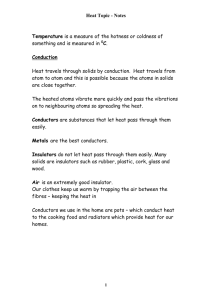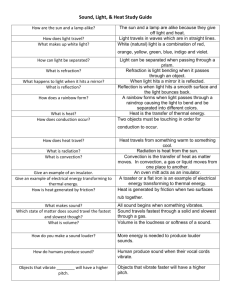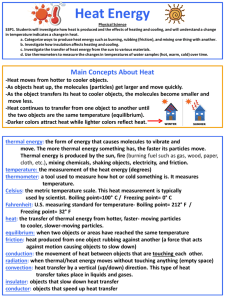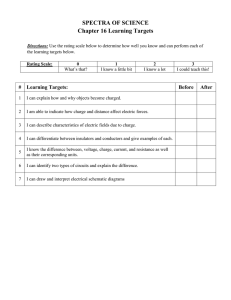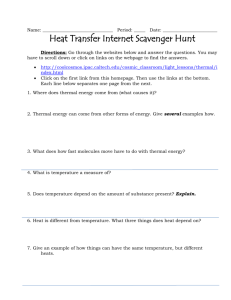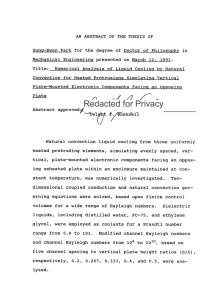Document
advertisement
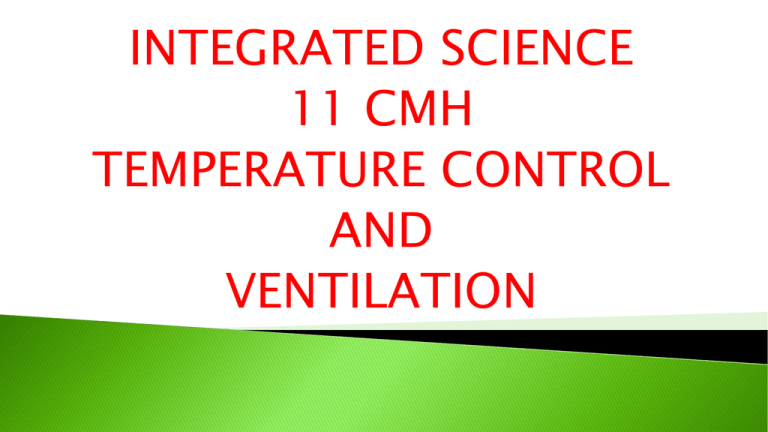
INTEGRATED SCIENCE 11 CMH TEMPERATURE CONTROL AND VENTILATION What is heat ? Heat is a form of energy. Heat can transfer from one place to another. Heat is also known as thermal or internal energy. Heat always transfer from a hotter place to one that is colder. What is Temperature? It is the intensity or the degree of heat in an object or substance. Temperature is also describe as the amount of heat energy in a substance. Methods of Heat Transfer Conduction This is the transfer of heat energy through a solid. The particles of the solid will vibrate continuously (kinetic energy). More kinetic movement means higher temperature. The particles of solid are held closely together. If one end of a solid is heated its particles will vibrate a lot gaining more energy. Nearby particles will now start to vibrate more (get hotter). Hence heat energy is been transferred through that solid. For most solid this process is very slow. Conductors and Insulators Metals are good conductors of heat. Liquids and gases normally poor conductors . Poor conductors such as wood, glass and paper are called good insulators. Material which contains trapped air, such as Styrofoam is a good insulator. NB Water is a poor conductor of Heat In the picture below water is believed to be a poor conductor of heat. As you can see piece of ice is placed at the base of the test tube. When heated the water at the top of the test tube will boil before the heat is conducted to the water at the bottom to melt the ice. Conduction in the Kitchen Cooking pots are good conductors. Heat from electrical or gas ring on the stove. If pot halides are made from metals it will burn you. Hence why some pot handles are made from insulators such as wood and plastic. You will have to use a piece of cloth to hold metal pot handle to prevent burnt to the hands. The cloth is a good insulator and a poor conductor of heat. Convection The movement of heat energy through liquids and gases. The heat is transferred from one part of the substance to another by movement of the liquid or gas particles themselves. Liquid particles are not bound as tightly to each other as solids. They are able to move so the liquid can flow. When one part of a liquid is heated, the particles vibrate more and push each other further apart. This part of the liquids expands and becomes less dense. This makes it rise upwards and is replaced by cooler liquid which is then heated and rises. Convection Current Convection currents are found in: 1. hot water tanks 2. Oven 3. Refrigerators The heating element is place at the bottom in hot water tank. The water at the bottom heats up and rises upwards. This is replaced by colder water from the top of the tank. This convection current will continue until all the water in the tank is heated. Sea Breezes At Day This is an example of natural convection currents. During day times the land heats up much faster than the sea. The land then heat the air above it. The warm air then rises. Cold air from the sea replace it. GLASSORY Insulator - A material or an object that does not easily allow heat, electricity, light, or sound to pass through it. Air, cloth and rubber are good electrical insulators
